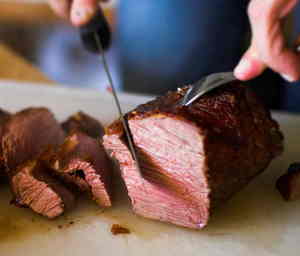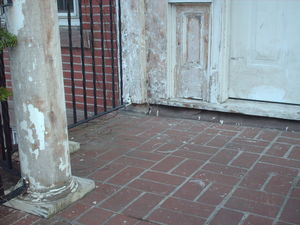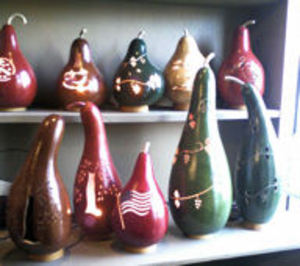Slicing meat is not as complex an art form as depicted in commercials or paintings, but it does require learning the basics. The most important thing to remember is to use the proper equipment. In addition to a well-sharpened carving knife invest in a strong, two-pronged carving fork. Have a heated serving platter or dinner plates close at hand.
Generally Speaking
Correctly slicing a roast or poultry will depend on the grain. Meat consists of thousands of strands of muscle or flesh. Carving across the strands (against the grain) will cause the cuts to be tenderer than cutting with or parallel to them.
Beef Roast
Rest the roast on the cutting board with the grain going up and down. You may need to slice the end off the roast to cause a flat surface. If slicing a beef rib roast you will slice horizontally until reaching the rib. Then slice vertically down along the rib until the slice is loosened. Slide the knife under the slice, steadying it from above with a slight piercing of the fork and set it on the serving platter or dinner plate. Before serving, brush with the drippings or gravy for an attractive glaze.
Pork Loin Roast
Choose a bone-in pork loin and have the butcher remove the backbone. Slice down the center of the meat, between the ribs, so that every serving has a bone. Smaller servings can be created by cutting down right along the sides of two ribs creating a thin boneless slice from meat in between and alternating with slightly thicker bone-in slices. Before serving, brush each slice with the drippings or warmed applesauce.
Leg of Lamb
Create a flat surface by taking a vertical slice from the thinnest side, not end, of the roast. Then turn and settle the flat side against the cutting board. Slice the meat perpendicular to the bone, making slices straight down and stopping at the bone. Continue until you have multiple slices in the meat as if creating a fan. Then cut parallel to the bone, detaching the slices. The remaining meat from the other side of the bone should be cut off in one piece. It can then be sliced in smaller pieces. Note: It is also appropriate to carve long slices parallel to the bone, as lamb is tender enough to cut with the grain.
Bone-in or Whole Ham
If you have not purchased a spiral sliced ham, it will slice in much the same fashion as Leg of Lamb but should not be cut with the grain. Steady the ham for slicing by cutting off a slice or two from the thinnest side to create a flat surface. Then proceed exactly as indicated in the instructions for slicing the leg of lamb.
Poultry
Most poultry will be carved in the same manner. Begin by removing the drumsticks and the thighs, slicing through the joints. The experienced cook can find the natural division in the joints to successfully detach the leg from the thigh and the thigh from the main body. When slicing large drumsticks, the leg is held upright against the cutting board and slices taken lengthwise down to the board. The same can be accomplished with the thighs. With the bird resting on the board on its back, make a cut in the breast meat, horizontal with the cutting board where the back and breast meet. The cut should be the entire length of the bird. Then slice the breast meat by taking thin, downward cuts parallel to the breastbone. The slices should separate and can be moved to the serving platter.
Helpful tips
* Carve on a plastic or wood carving board with a lip or juice well.
* Meat should be anchored firmly with the fork while carving.
* Too many punctures in the meat will create a slippery surface.
* Slices should be 1/4 to 1/2 inch thick
* Slices that are uniform in thickness are best for presentation.
* Heat the serving platter or dinner plates prior to carving the roast.
Note:
I thank you for your visit. If this information has been helpful, please share this article with your friends. You’ll find a convenient email button directly above the article title! I encourage my readers to rate and leave comments on every article published here.





